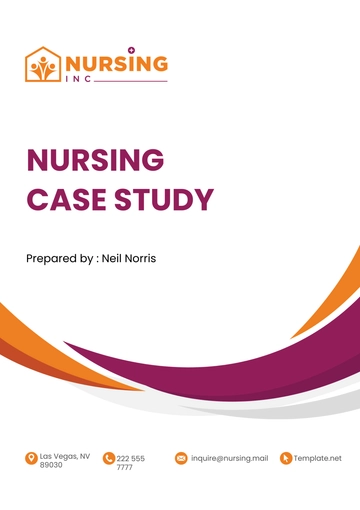Child Case Study
I. Introduction
This case study provides a detailed analysis of [Child's Name], focusing on their developmental progress, the challenges they face, and the interventions implemented to aid their growth. The objective of this document is to gather and organize diverse sources of data to create a comprehensive understanding of the child's situation, enabling effective strategies to foster their developmental journey.
II. Student Information
III. Background Information
Medical History: Provide a medical history for the child covering existing medical conditions, allergies, and past medical procedures such as surgeries and hospitalizations. Also, mention current treatments or medications, and if any medical specialists are involved in their healthcare, do include their names and fields of expertise.
Developmental History: Describe the child's developmental milestones, early experiences, impacts on growth, and any developmental concerns raised by caregivers or professionals. Also, record any implemented interventions for these developmental issues.
Educational History: Outline the child's educational journey, including school transitions, academic achievements, areas of strength and weakness, educational assessments, and any specialized services received (e.g., special education, gifted programs).
Socioeconomic Factors: Discuss the child's environment including family's financial status, healthcare, education, cultural factors, community, and social obstacles.
IV. Assessment and Evaluation:
Academic Performance: Evaluate the child's performance in various subjects, standardized test scores, homework completion rates, class participation, strengths, and areas needing improvement.
Behavioral Observations: Document observable behaviors such as attention span, impulsivity, social interactions, compliance with rules, conflicts with peers or adults, and any behavioral patterns across settings.
Emotional Assessment: Assess the child's emotional regulation skills, coping mechanisms, expressions of feelings (e.g., anxiety, sadness, anger), response to stressors, and overall emotional well-being.
Social Skills Evaluation: Evaluate the child's social interactions, friendships, communication skills (verbal and nonverbal), ability to collaborate in group settings, empathy, and understanding of social cues.
Learning Style: Identify the child's preferred learning modalities (visual, auditory, kinesthetic), learning pace, attention span, memory retention techniques, and environmental factors that enhance or hinder learning.
V. Challenges and Concerns
Academic Challenges: Specify areas where the child struggles academically, barriers to learning, difficulty with specific subjects or skills, and factors contributing to academic setbacks.
Behavioral Concerns: Address disruptive behaviors, attention difficulties, hyperactivity, defiance, aggression, withdrawal, or any behaviors affecting learning and social interactions.
Emotional/Well-being Issues: Highlighting emotional challenges like anxiety, depression, and low self-esteem is crucial. These issues may manifest as traumatic symptoms, causing mood swings that considerably affect daily life.
Social Difficulties: Discuss challenges in forming and maintaining relationships, peer conflicts, social isolation, bullying experiences, social anxiety, or difficulties in understanding social norms.
VI. Interventions and Strategies
Academic Interventions: Detail specific instructional strategies, accommodations (e.g., extra time, visual aids), tutoring, remedial programs, and modifications to curriculum or assignments.
Behavioral Strategies: Outline behavior management techniques, behavior plans (e.g., token systems, reinforcement schedules), counseling interventions, and collaboration with school counselors or psychologists.
Emotional Support: Describe counseling services, emotional regulation techniques (e.g., mindfulness, deep breathing exercises), support groups, and collaborations with mental health professionals.
Social Skills Development: Plan social skills training sessions, peer buddy programs, role-playing activities, social stories, and opportunities for structured social interactions.
Individualized Accommodations: List specific accommodations tailored to the child's needs, such as preferential seating, assistive technology, modified assignments, or alternative assessment methods.
VII. Progress Monitoring
Academic Progress: Track improvements in academic performance, mastery of skills, completion of goals, progress in individualized education plans (IEPs), and feedback from teachers and specialists.
Behavioral Changes: Document changes in behavior, reduction in problematic behaviors, improved self-regulation, adherence to behavior plans, and feedback from caregivers and school staff.
Emotional Well-being: Monitor changes in emotional stability, coping skills, engagement in therapeutic interventions, and feedback from mental health professionals and caregivers.
Social Interaction: Note improvements in social interactions, peer relationships, participation in group activities, conflict resolution skills, and feedback from peers and teachers.
VIII. Outcomes and Recommendations
Achievements and Improvements: Celebrate accomplishments, improvements in targeted areas, mastery of skills, positive changes in behavior and emotional well-being, and strengths recognition.
Challenges Remaining: Strive to detect sustained difficulties, be aware of persistent needs that need enhanced support, closely examine the obstacles impeding progress, and determine areas needing continual intervention along with areas requiring vigilant supervision.
Recommendations for Further Support: Provide specific recommendations for additional services (e.g., counseling, speech therapy, occupational therapy), referrals to specialists, parental training programs, and collaboration with community resources.
Collaborative Efforts: Outline collaboration strategies with parents, school staff, therapists, and other professionals involved in the child's care, including regular communication channels, team meetings, and shared goal-setting.
IX. Conclusion
This case study of [Child's Name] has systematically documented the developmental journey, challenges, interventions, and outcomes involved in their unique case. It serves not only as a record but also as a guideline for similar future cases that might benefit from an integrated understanding of child development interventions.
Case Study Templates @ Template.net






























